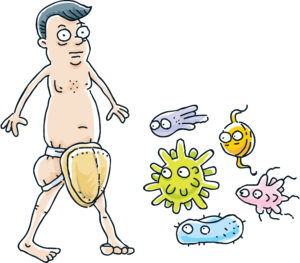
It’s time for you to be in the know when it comes to STDs.
Image: Shutterstock
Itching, burning, and warts in unfortunate places—the CDC tells us that sexually transmitted diseases (STDs) are at an all-time high. That makes it the perfect time to up your game when it comes to recognizing STD symptoms, getting treatment, or—best of all—avoiding STDs altogether. Here’s a quick rundown of four biggies and what you need to know about them.
Chlamydia
What is it?
Chlamydia is a bacterial infection spread through sexual contact. It’s especially common in people 25 and younger.
What are the symptoms?
Often you won’t get any symptoms at all, which makes it hard to diagnose. If you do, you’re likely to experience abdominal pain, vaginal discharge, and a low-grade fever (women) or pain while urinating, milky discharge from the genitals, and swelling around the anus (men).
What do I do about it?
Chlamydia is easy to treat with antibiotics. Be sure to get both yourself and your partner tested and treated.
Genital Warts
What is it?
Genital warts are a common STD caused by some types of the human papilloma virus (HPV) and transmitted by skin-to-skin contact. They can be unpleasant, but they’re usually not dangerous. Some strains can cause cervical cancer so its important to get checked with at least an annual pap smear which can pick up precancerous changes
What are the symptoms?
You’ll find small flesh-colored bumps on the skin around the genital area and/or anus. They often cluster together in itchy masses.
What do I do about it?
See a health professional about having them treated. Treatment may include topical medication, freezing or burning off the lesions and sometimes surgical excision. Make sure that you (if you are female) or your female partner has a routine pap smear and examination Down side: They often come back.
Gonorrhea
What is it?
Gonorrhea is a bacterial infection passed during sexual contact. You might’ve heard it called “the clap” or “the drip.” It infects the penis, vagina, cervix, anus, urethra, or throat. It’s pretty common—more than 800,000 men and women in the US suffer from it every year—and it can become a serious health risk if it isn’t treated. It often shows up along with chlamydia in one of the nastiest two-for-one situations out there.
What are the symptoms?
Most of the time there are no symptoms. If you do experience some, they will likely include abdominal pain, nausea, and fever (women) or pain while urinating and a pus-like discharge from the penis (men). Both genders often have the joy of experiencing an itchy anus as well.
What do I do about it?
Luckily, gonorrhea is easily treated with a round of antibiotics. However, teens and pregnant women should be careful about what they take—definitely consult your healthcare provider.
Crabs
What is it?
Crabs are genital lice. These microscopic insects are parasites that live on pubic hair and suck blood 4 to 5 times a day. They lay eggs frequently and they are passed from human to human primarily with sexual contact.
What are the symptoms?
The symptoms are pubic itching. Small white eggs may be noticible in the pubic hair. In some cases a person’s eyelashes may become infested as they like coarse hair.
What do I do about it?
Prescription medicated shampoo can eliminate pubic lice. Linens and clothing will need to be washed on hot cycle as well. Retreatment in 8 or 9 days may be required. Interestingly as more people are shaving their genitals the incidence of pubic lice may be decreasing.
These are only four examples of the STDs that are out there. There’s no need to live in fear, though; you can easily find plenty of good information about preventing and treating STDs.
And here’s the best tip of all: GET TESTED! It’s confidential, and it’ll save you a world of pain—not to mention itching in awkward places.
